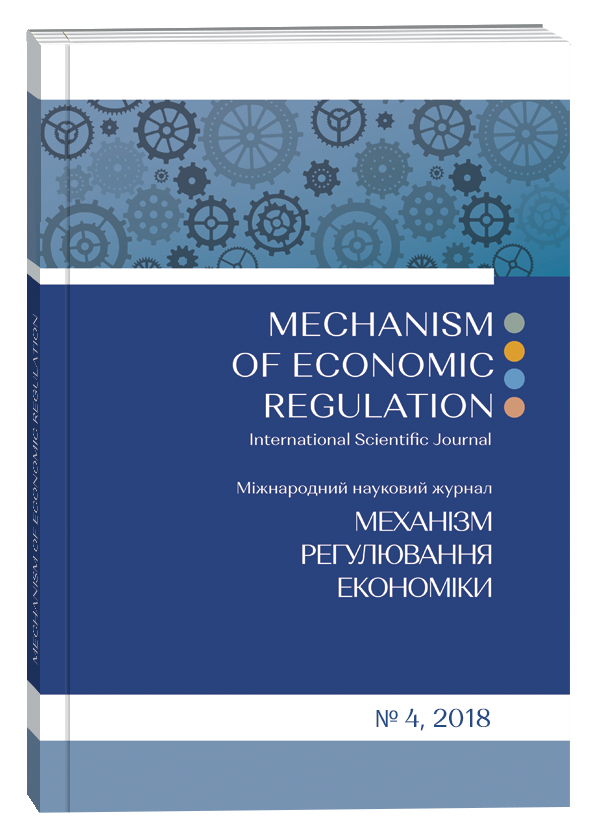THE ASYMMETRIC TYPE OF ECONOMIC EQUILIBRIUM AND SOFT BUDGET CONSTRAINTS
Abstract
The article considers asymmetric information in its relation to the type of economic equilibrium and the problem of the soft budget constraint, using the planned economy of the former USSR as the main example. In the article, it is supposed that the market with asymmetric information should be characterized by asymmetric arrangement of the curves of supply and demand. In its turn, such an assumption is connected with another hypothesis, according to which the curves of supply and demand describe the dispersion of prices, which characterizes a relevant market. On the basis of this dispersion (probabilistic) approach to using the neoclassical curves of supply and demand, it is proposed to consider the soft budget constraints at a macro level. The SBC that characterizes the centrally planned economy is in accordance with an asymmetric arrangement of the curves under consideration. The situation of comparatively hard budget constraint corresponds to the classical symmetric crossing of the curves of supply and demand, which also characterizes the market economy. Also, for the case of the market economy, the shift of the curve of the aggregate demand (primarily under the influence of credit expansion) in the less elastic position is related with both phenomena – the expansion of the soft budget constraint syndrome and a weakening of macroeconomic stability. In turn, this process is accompanied by a growth of asymmetry of information and a process of adverse selection in an economy. The latter means, for example, the growth of financial bubble and of the share of those investments (and economic actors), which have a predominantly speculative nature and, in particular, are not connected with technological innovations that favour the growth of productivity in the whole economy.
References
Voznaya, L. (2014). Obshchaya teoriya ustoychivosti sotsial'no-ekonomicheskikh sistem [The general theory of the socio-economic systems stability]. Zhitomir: Izd-vo Evenok A.A., 320.
Geyets, V., Voznaya, L. (1998). Asimmetrichnyi tip ravnovesiya i krizis predlozheniya v perehodnoy ekonomike [Asymmetric type of equilibrium and the supply crisis in the transition economy]. Ekonomicheskaya nauka sovremennoy Rossiyi, 4, 31–44.
Koropetskiy, I.-S. (1998). Ekonomichni pratsi: Zbirnyk vybranyh statey [Economic works: collection of selected articles]. Kyiv: Smoloskyp, 414.
Makarov, V. (1997). O primeneniyi metoda evoliutsionnoy ekonomiki [On the application of the method of evolutionary economics]. Voprosy Ekonomiki, 3, 18–26.
Melamed, М. (1997). Ekonomichnyi portret u mizhnarodnomu vymiri [Economic portrait in the international interior]. Visnyk NBU, 11, 20–28.
Men’shikov, S. (1990). Sovetskaya ekonomika: katastrofa ili katarsis? [The Soviet economy: a catastrophe or catharsis?]. Moscow: Inter-Verso, 400.
Mnyh, M. (1993). Monopolizatsiya ekonomiky Ukrainy i mozhlyvosti provedennya antymonopol’noyi polityky [Monopolization of the Ukrainian economy and the possibility of the conducting of antimonopoly policy]. Ekonomika Ukrainy, 3, 35–41.
Eucken, W. (1995). Osnovnyie printsipy ekonomicheskoy politiki [Grundsätze der Wirtschaftspolitik]. Moscow: Progress, 496.
Ol’sevich, Yu., Vasilieva, R., et al. (1991). K sbalansirovannoy ekonomike: dialog s sovetologami [Towards a Balanced Economy: The Dialogue with Sovietologists]. Kiev: Izd-vo KGU, 176.
Smirnov, V. (1998). Mineral’no-syrievoy kompleks v strukture ekonomiki Rossii [Mineral and raw materials complex in the structure of the Russian economy]. Voprosy Ekonomiki, 4, 144–154.
Akerlof, G. A. (1970). The market for “lemons”: Quality uncertainty and the market mechanism. The Quarterly Journal of Economics, 84(3), 488–500.
Bayew, M. R., Morgan, J., & Scholten, P. (2004). Price Dispersion in the Small and in the Large. The Journal of Industrial Economics, 4, 463–496.
Ickes, B. W. (1986). Cyclical Fluctuations in Centrally Planned Economies: A Critique of the Literature. Soviet Studies, 38(1), 36-52.
Kirman, A. (2010). Complex Economics: Individual and Collective Rationality. London and New York: Routledge, 230.
Knight, F. H. (1921). Risk, Uncertainty, and Profit. Retrieved from http://www.econlib.org/library/Knight/knRUP.html.
Kornai, J. (2014). The Soft Budget Constraint. Acta Oeconomica, 64(S1), 25–79.
Kornai, J. (2012). What Economics of Shortage and the Socialist System Have to Say to the (Hungarian) Readers Today. Acta Oeconomica, 62(3), 365–384.
Kornai, J. (1980). Economics of shortage. Amsterdam: North-Holland Pub. Co., 631.
Kotosz, B. (2014). Heterodoxies in the Work of János Kornai: How Far from the Mainstream? Journal of Heterodox Economics, 1(2), 131–144.
Maskin, E. S. (1996). Theories of the soft budget-constraint. Japan and the World Economy, 8, 125–133.
Porter, M. (1980). Competitive Strategy: Techniques for Analyzing Industries and Competitors. New York: The Free Press, 416.
Sraffa, P. (1926). The Laws of Returns Under Competitive Conditions. The Economic Journal, 36(144), 535–550.


